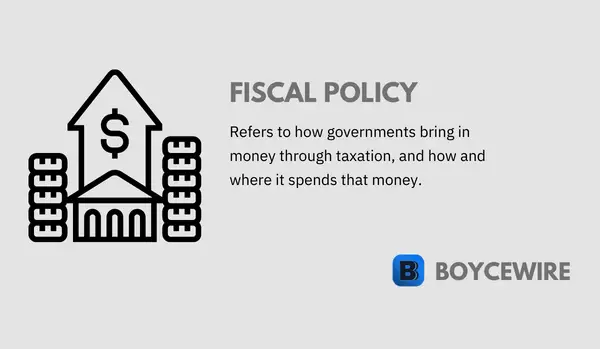Fiscal Policy: Definition, Tools & Objectives

What is Fiscal Policy
Fiscal policy refers to governments spending and taxation. So how much income it has coming in through taxes, and how much it has going out through spending such as welfare, defence, and education.
Fiscal policy is a very politicised area as the government has sole control over it. This is in stark contrast to monetary policy which is controlled generally by an independent central bank.
In short, fiscal policy is defined by what governments choose to spend money on and how much they want to bring in from the taxpayer. For instance, the government may come under pressure from the public to invest more in local schools. It may have to borrow the money or increase taxes. A balancing act for fiscal policymakers.
Key Points
- Fiscal policy refers to how government receives and spends money.
- Fiscal policy can be seen from two perspectives – taxation and spending.
- There are six main objectives of fiscal policy – full employment, economic growth, control debt, control inflation, re-distribution, and polictical.
Fiscal Policy Tools
When deciding fiscal policy, government officials have two tools that they can use. They are taxation and spending. Whilst they are somewhat interlinked, they are not completely dependent on each other.

For example, governments frequently spend more than they bring in through taxation. Also known as a budget deficit, the fiscal policy does not consider the need to raise taxes to fund expenditure. Over the long-term, this can be ruinous as can be seen in Greece.
1. Taxation as a Fiscal Tool
Governments use taxation as a way of funding expenditures. However, higher taxes are generally unpopular with voters. Yet they generally want greater spending in areas such as education, defence, and healthcare. So there is a tough balancing act that most governments don’t follow; frequently spending more than they receive in taxes.
The ‘big’ types of taxation such as sales and income are generally left untouched. However, governments have developed other means that are less politically sensitive. For instance, inheritance tax, corporation tax, land tax, and so on. In turn, these types allow government to raise revenue without drastically affecting its popularity among the masses.
Consequently, these methods are used to essentially control their expenditure, allowing greater flexibility at a lower political cost. However, higher taxes do not necessarily mean higher revenue – as the Laffer Curve demonstrates. So governments must tread a fine line in maximising revenue.
General Aims of Taxation
The general aim of taxation as fiscal policy is to fund expenditure. However, it is also used to help stimulate the economy; particularly during a recession. Governments can do this by reducing the level of taxation. To explain; more money in private hands can boost consumer confidence and spending. If each household has an additional $1,000, that means more money can be spent in the economy.
At the same time, more money in private hands means less for government spending. However, it is far cheaper to reduce taxes in a recession than an economic boom. This is because there are fewer jobs (lower income tax receipts) and lower corporate profits (lower corporate tax receipts). So the opportunity cost is lower.
There are also several other non-revenue objectives of taxation:
1. Regulating Consumption
Governments may look to dis-incentivise the consumption of demerit goods such as cigarettes or sugary soft drinks.
2. Protecting Domestic Industries
Tariffs or taxes on imported goods make international alternatives more expensive. In turn, domestic companies can compete more effectively on price.
3. Encourage Investment
Surcharges on goods such as oil and gas make it more expensive for consumers. In turn, this can impact on consumption, thereby reducing profits. Such companies may then look to diversify into other areas such as renewable energy where the tax regime is not so strict.
4. Reduce Inequality
Perhaps one of the most prominent aims in society today is for taxation to reduce inequality.
2. Spending as a Fiscal Tool
Government spending is another type of fiscal policy and plays an important part in shaping the overall economy.
In FY 2019, the US government (federal, state, and local) spent over $4.4 trillion. Social security is the biggest expense, accounting for roughly $1.1 trillion in expenditures. Whilst Medicare, Medicaid, and Defence amount ‘to a combined $2 trillion.
In the US, government spending accounts for roughly 40 percent of GDP. How it spends that money is crucially important.
As it stands, trillions are being spent on wealth transfers in the form of social security, Medicare, and Medicaid. Even across other developed nations, healthcare and social transfers are big expenditures.
Aims of Government Spending
The general aim of government spending is to deliver on its key responsibilities such as defence, and law and order. However, over the past 100 years, it has developed into a social structure to protect the poor, vulnerable, and needy.
The aims of government spending developed from the desire to obtain social justice and redistribution. They can be summarized below:
1. Reduce Inequality
Social security is a prominent method by which governments aim to reduce inequality through redistribution.
2. Public Support
Governments spend money in order to gain public support. If the public see more ‘free’ public services opening, they are more likely to favour the existing government.
3. Increase Economic Growth
Higher government spending has the potential to increase economic growth. However, it depends at what point of the business cycle it occurs at. For instance, when going through an economic boom, it is unlikely to help as it starves private firms of capital. At the same time, if spending is stimulated through borrowing, it may improve the economy in the short-term, but will cause greater problems in the long term.
4. Defence
There is a constant global threat from international powers. Not only physically, but also in terms of intellectual property and other non-physical attacks. For instance, cyber-crime has become an increasingly prominent issue in national defence.
5. Law and Order
Traditionally seen as a service that the private sector would be unable to offer. Therefore, it is in the interest of all parties to ensure there is a deterrent.
6 Objectives of Fiscal Policy
Governments have several objectives in mind when deciding on fiscal policy. The six main ones are listed below. However, they are not necessarily considered in the same fashion. For instance, some governments, like Greece, may be forced into controlling debt over full employment. In the same fashion, a country in a sound financial situation may wish to target full employment over controlling its small level of debt.
Governments may favour one objective over the others. So let us look at what the six main objectives of fiscal policy are.
1. Full Employment
One of the governments main objectives is to keep and get people into work. Not only do governments benefit from higher taxes, but also from lower expenditures on social security. An expansionary policy may look to invest in infrastructure which would directly create employment. Alternatively, it may reduce taxes to give consumers more money to indirectly stimulate employment from their purchases.
2. Economic Growth
As an economy grows, its citizens, on the whole, become more prosperous. So this is an important objective. At the same time, governments must be careful. An aggressive expansionary fiscal policy could prove detrimental in the long-term. We only need to look at Greece as an example.
Whilst economic growth is an understandable aim, it must also be considered alongside stability. For instance, heavy government spending can contribute to inflation. Too much spending and it can create high levels of debt and an inflation rate that destroys the nation’s wealth.
3. Control Debt
Running a budget deficit is not necessarily bad. However, over time it creates more and more debt. If economic growth and tax receipts do not increase it line, a nation faces an unsustainable level of debt. A rational fiscal policy would aim to control this before having to take drastic action.
4. Control Inflation
When an economy is growing strongly, it may experience high levels of inflation (this may also depend on monetary policy). As 2 percent is generally the target, anything above this is a cause for concern: particularly if it is consistently above. Even though inflation is a monetary phenomenon, there are steps governments take to try and stem such. With that said, there is little fiscal policy can do if the money supply has been let loose. Nevertheless, governments try by increasing taxes to reduce disposable incomes and hence consumption.
5. Re-distribution
Another aim of the government is to transfer wealth from the rich to the poor. Higher taxes on the rich can sometimes result in high tax receipts, but this is not always the case. Evasion and avoidance may occur, or they may in fact just leave the country. Although small incremental increases may not have such a significant impact in the short-term.
6. Political
Fiscal policy has inevitably become a political tool that many incumbent governments use in a bit to get re-elected. A loosening of fiscal policy and greater spending can often win some ‘floating voters’ over.
Fiscal vs Monetary Policy
What is the difference between fiscal and monetary policy? It can be quite confusing, so let us break it down.
First of all, fiscal is defined as relating to government finance and taxes. In other words, anything relating to government spending or how much it brings in through taxation is fiscal policy. By contrast, monetary is define as relating to the money in a country. So monetary policy is to do with a nation’s money supply. How money is created and the policies that increase or decrease its supply.
In short, fiscal policy refers to tax and government spending, whilst monetary policy refers to money, how it is created, and how its supply is controlled.
FAQs on Fiscal Policy
Fiscal policy refers to governments spending and taxation. So how much income it has coming in through taxes, and how much it has going out through spending such as welfare, defence, and education.
Governments use a number of different fiscal policies, each with different effects. This is split down between taxation and spending. So an example could include income tax, corporation tax, or sales tax. It could also include spending such as welfare, defence, and policing.
Fiscal policy refers to what the government takes in through taxes and spends through borrowing and taxes. By contrast, monetary policy controls the supply of money that is organised by central banks.
About Paul
Paul Boyce is an economics editor with over 10 years experience in the industry. Currently working as a consultant within the financial services sector, Paul is the CEO and chief editor of BoyceWire. He has written publications for FEE, the Mises Institute, and many others.

Further Reading
 The Importance of Property Rights - An efficient free market is reliant on strong property rights as a fish is to water. Its purpose is to…
The Importance of Property Rights - An efficient free market is reliant on strong property rights as a fish is to water. Its purpose is to…  Cash Cow - A cash cow refers to a business or product that generates a steady and significant cash flow with minimal investment…
Cash Cow - A cash cow refers to a business or product that generates a steady and significant cash flow with minimal investment…  Classified Balance Sheet - A classified balance sheet is a financial statement that categorizes a company's assets, liabilities, and equity into current and non-current…
Classified Balance Sheet - A classified balance sheet is a financial statement that categorizes a company's assets, liabilities, and equity into current and non-current… 